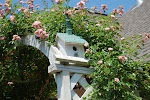1. Your Instruction Guide for Priscilla's Layette is the valuable tool that tells you what you need to know to make your garment. It will tell you the order to put the pieces together and the method that should be used to put them together. So get your Instruction Guide out. You should have already read the instructions for review. We are making View 2. The instructions refer us to View 1 for the layout guide. You will use the pattern pieces listed in View 2 and follow the layout in View 1. I am using the shorter (3/4 length) sleeve but if I lived in the North, I would use the long sleeve for View 2. You need to cut apart the pattern pieces you will use (do not cut around the lines like a paper doll, just separate them). I like to press mine with a dry iron to flatten them. Be gentle so the pattern doesn't tear.
2. Layout - Fold the fabric as directed with selvages meeting. Smooth out all the wrinkles. Lay the pattern on top of the fabric as directed on the Layout Guide. Use pattern weights to keep each pattern piece in place while you arrange them. When you have them just right, then you are ready to pin them in place. This saves you the unpleasant task of unpinning the pattern to re-arrange it.
Pattern arranged on the fabric and held in place with Pattern Weights
The Layout Guide shows the Bias for the sleeve and also for the Neck. There is a Bias Sleeve pattern piece, but not a pattern piece for the neck. We are told to cut out the Neck Bias using the measurment in Step 4. We need to plan for this as we lay out our pattern on top of the fabric. We need to make sure there is room for the neck bias.
3. Bias Binding - The fabric must be cut on the "true" bias (45 degree angle). It is easy to do this if you have a ruler with the 45 degree angle on it.
Place the 45 degree line along the selvage of the fabric. Use a fabric marking pen or pencil and draw the bias line. Step 4 tells us the Neck Bias should be 12 1/2" long X 7/8" wide. Draw the line 12 1/2" long.
I like to use my smaller 2" X 18" gridded ruler to trace the width (7/8"). It is more accurate because I can see the line easily. Trace the correct size. You now have the Bias Neck band on your fabric. We only need one piece for the neck but it is just as easy to cut two. Shown here is a Neck Bias that is the same color as the gown. Mine will be red/white mini gingham so I will use a separate piece of fabric to cut my bias. It will require almost 1/3 yard of fabric to make.
4. Pinning the pattern - We want to make sure the pattern is laid onto the fabric correctly before we pin it in place. Read the markings on the pattern pieces. The Daygown Back must be on the Fabric Fold. The Daygown Front is placed along the selvage. We don't want to line the pattern up right along the selvage because the fabric weave is tighter there and can cause your gown to pucker. We will avoid the edge and move our pattern piece in about 1/2" to 3/4".
The black cutting line of the Daygown Front is placed a short distance from the selvage.
The seam allowance for this Daygown is not large (1/4" and 3/8" in places) so it is important to pin the pattern securely to the fabric. If the pattern slips while you are cutting, you can change the seam allowance which will affect the garment pieces going together nicely.
Pins are placed along the cutting line, closely spaced. Take care that corners and curves are secured.
When we pin the sleeve, we need to make sure it is pinned on the straight of grain of the fabric. This affects the fit and is very important. Pattern pieces that are not placed along the selvage or the fold usually have a Grain Line printed on the pattern. It is a straight line with little arrows on either end. The Grain Line needs to be parallel to the selvage of the fabric.
Line up the ruler with the grain line and the selvage.
Here you see the ruler lined up with the grain line.
Line the ruler up with the grain line. Both the grain line and the selvage should be straight.
 5. Cutting Out - Cut on the outside of the black cutting line. If you cut inside the black cutting line, you are cutting the pattern smaller than it was designed to be.
5. Cutting Out - Cut on the outside of the black cutting line. If you cut inside the black cutting line, you are cutting the pattern smaller than it was designed to be.I like to use a 7" Scissor instead of the larger, more standard size. I find when cutting out little garments, I have more control of the scissor when it is smaller.
6. Marking the fabric - It is important to mark the pattern before unpinning. Your pattern guide will tell you what you need to mark.
Do the same to mark the dots that show where fabric will be gathered.
An easy way to mark buttonhole placement is to insert a pin at the top of every buttonhole and mark with a fabric marker . That will insure that they are correctly and evenly spaced. Use a fabric marker to mark a dot where the pin is. Later, when you are ready to sew the buttonhole, use the button to get the correct length. We will mark the entire buttonhole later, when we stitch them. Use the same method to mark the dots that indicate where the gathering will be. It is also used to mark the back of the sleeve so you can tell it from the front. The pin goes all the way through the fabric so you can mark both sides.
Mark the foldline for the front facing at the top and bottom and use a ruler to trace the entire fold line. Only the inside fold line needs to be marked (the line farthest away from the edge of the fabric).
Place a piece of masking or painters tape on the wrong side of each piece of fabric. It is important to know the right side from the wrong side. If the tape does not stick, use a tiny safety pin. Keep the pattern piece attached to the fabric with one pin until you are ready to sew that piece.
All ready to begin sewing.
Please let me know if this information is useful by leaving me a comment or a question. I will answer them as often as I can.
Next Lesson - Begin Sewing. Make sure your Sewing Machine is clean and in good working order!!










































































































5 comments:
I think that Priscilla's Layette is one of the few patterns that I don't have. I like the tip about using 7" scissors, I might look into getting a pair of them, along with the pattern.
Jeannie, you are a step ahead of me on the daygown. I'm glad you chose this pattern as the first on your blog. I enjoyed seeing and hearing about the market - it looks like so much fun (but work too I am sure).
I was told once that the size of the scissors was really to be determined by your hand size. I have small hands and really enjoy the 7 in more. Just wish they would make them in the pretty colors! I do not think I will get to this gown until after SAGA though.
Thank you so much, Jeannie! This information is so helpful ~ it's great to know exactly how you do things, since I wish my gowns could turn out as beautiful as yours!
This is helping me so much. I have never done this and was lost in where to start
Post a Comment